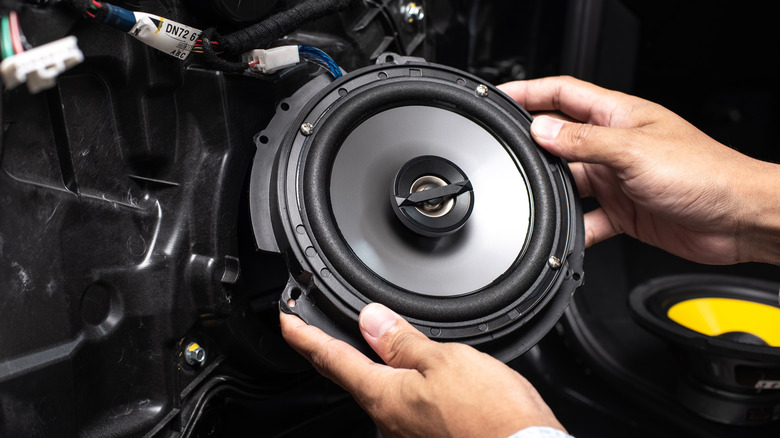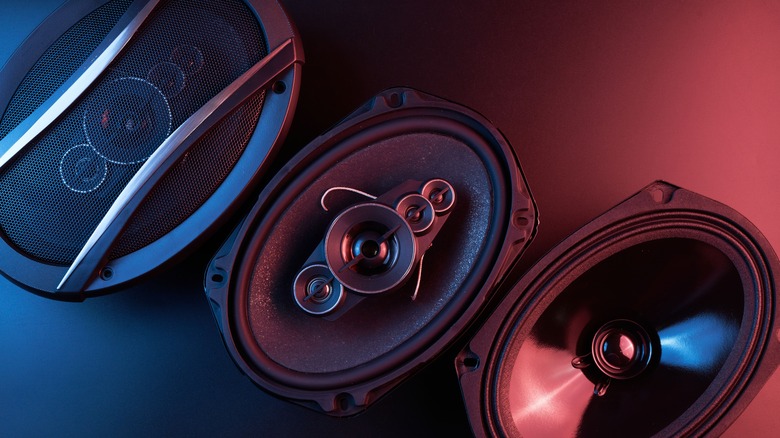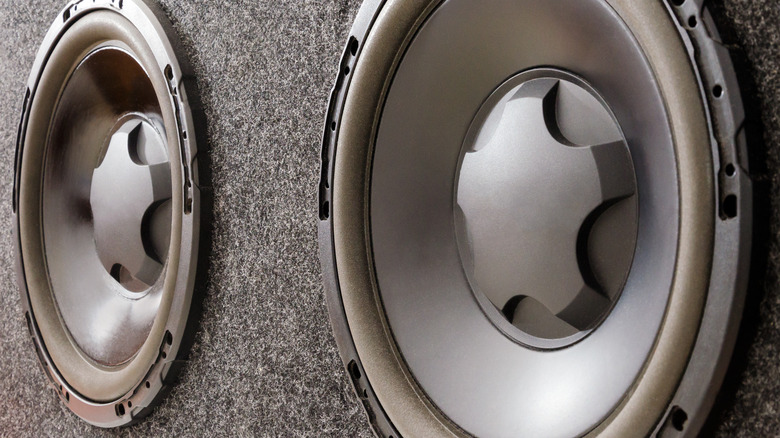4 Things To Look For When Shopping For New Car Speakers
We may receive a commission on purchases made from links.
There are many different reasons someone could be in the market for new car speakers. You could also be looking for a replacement for your blown speaker. If that's you, many enthusiasts will tell you not to replace them with the single-cone speakers your car probably came with but instead shell out a few bucks on some non-standard speakers. Your music could sound substantially better with a proper set of speakers that make the most out of your stereo system. But knowing what to look for with all the complicated jargon thrown around when speakers are discussed can be challenging.
Before getting into the technical aspects of sound quality, you must know what speakers will fit your vehicle. Look at the speaker size and mounting depth to manually fit your speakers. You also need to ensure your prospective options fit within your car's speaker grilles if you have them. When in doubt, use Crutchfield. This website will ask you for the year and model of your vehicle and then provide you with compatible sound systems and speakers. From the long list of compatible products, you can choose the best speakers for you. Follow this guide if you don't know what you need in a good set of speakers.
Power handling
Power handling is how a speaker handles the electrical power that's fed into it, usually measured in watts. If the peak power handling of a speaker is exceeded, it can damage the speaker. It can also result in reduced performance, which can lead to sound distortion.
The root mean square (RMS) power handling is how much continuous power the speaker can take. The upper range of the RMS is often the most important to know because it tells you what you can safely achieve while also maintaining quality. Running your speakers within this level can also extend the life of your speaker.
A speaker's power handling is important to consider when shopping for a stereo or an amp. You want your speakers to match your amp's top RMS output. This can be done with speakers that have equal or higher RMS ratings. If you have speakers with different RMS wattage, things get tricky. In that case, you need to match up with the lowest amp RMS rating.
You can find the power handling of a speaker on the product page of your compatible speakers. It can also be found in the documents provided with a speaker. Sometimes, it is listed as a recommended amplifier, showing the minimum and maximum RMS range.
Speaker type
Deciding what type you want is arguably the most important decision you can make when shopping for car speakers. The decision usually comes down to coaxial versus component speakers. Each one has subcategories, but for this, we are just looking at the type so you can start your search.
Coaxial speakers have everything built into one speaker assembly. They are usually of higher quality than standard single-cone car speakers by providing full-range sounds. Coaxial speakers can also fix poor frequency response and produce missing upper-frequency sound range. This makes them a popular upgrade from your built-in speakers for many people. Another appealing aspect of this speaker type is that it is easy to install, sliding directly into the single-cone speaker slot. They are also quite affordable, making them a solid choice for those who want a sound upgrade that doesn't break the bank. That said, coaxial speakers won't give you the best quality around.
For the highest quality sound, you'll want component speakers. Component speakers have the woofer and tweeters separated into multiple pieces. This creates a three-dimensional listening space. They also often have higher power ratings and, thus, higher sound quality. The issue with these speakers is that they are hard to install, as you need a separate place to mount the tweeter. Not all cars have this space, so many people opt out of professional installation. They are also, on average, more expensive than coaxial speakers.
Impedance
Impedance measures a speaker's resistance to a power flow from an audio source. Measured as ohms (Ω), this is a very important spec for a car speaker. Systems and amps are designed to work with specific speaker impedances. For optimal listening, you need to match up the impedance of your speaker to your audio output.
If a speaker is outside the range of the output power, it can cause overheating or other faults that can damage the devices. It can also result in the distortion of audio.Lower impedance provides clarity at opposite ends of the rating, while higher impedance speakers are loaders. You can generally connect the speaker with high impedance to a lower impedance amp without any issue. But you don't want to connect a low-impedance amp to a high-impedance speaker.
For example, let's say your speaker has an impedance of 6 ohms. You can match that up with an amp that can support four to 16 ohms. Properly matching up your impedance on your tech is a crucial factor in speaker configuration that is sometimes overlooked.
Sensitivity
Speaker sensitivity is how efficiently a speaker can convert the power it is being sent into volume. The measurement is taken by looking at how many decibels can be heard at one meter from one watt of power. Thus, the higher sensitivity the speaker is, the louder it will be with the same amount of power as a less sensitive speaker. The standard range for speakers is 85-92dB, with 88dB considered average and 92dB considered high-end sensitivity.
People sometimes misunderstand that higher-sensitivity speakers do not mean better sound quality. For example, there are a ton of high-quality speakers that have low sensitivity. This is because they require more power to produce the premium sound.
It all depends on how much power you can provide the speaker. Low-sensitivity speakers have the obvious downside of requiring the user to have a high-powered amp. If you don't have a powerful amp already, consider buying a high-sensitivity speaker to make up for it to save you from having to upgrade.




